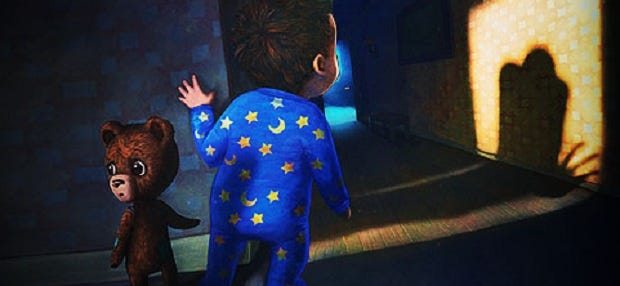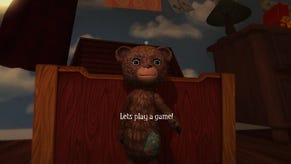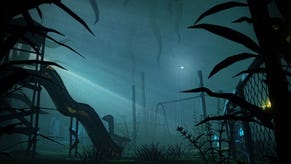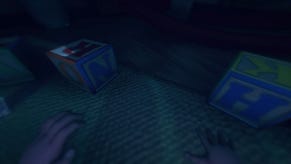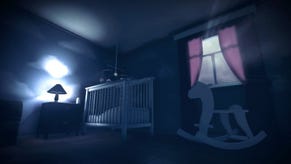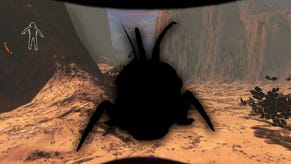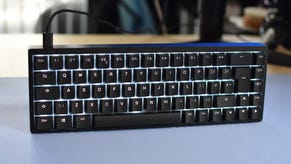Hands On: Among The Sleep
Throwing out the bathwater
During a recent trip to Oslo, I found two members of Krillbite working in the same office space as Red Thread Games. Before sitting down with Dreamfall Chapters, I spent a couple of hours in the company of a teddy bear, sucking my thumb in the dark. Among The Sleep is creepy, as I’d expected, but there are hints of something far darker than night terrors in its shattered domestic spaces.
In some ways, the first two chapters of Among The Sleep remind me of Gone Home far more than they remind me of Amnesia. Sure enough, a couple of moments caused me to flinch from the screen and there’s a tense, interactive reveal that had me gnawing my fist (always embarrassing when you’re in the same room as the developers at the time), but the overall experience isn’t simply about terrorising the toddler in us all.
The setting is spooky and there are many things going bump in the night - as well as several that shriek, scratch, rumble and snarl – but they are rarely snapping at the player’s heels. The intensity of the soundscape makes almost every object seem threatening but there is no immediate threat in the early stages. A flash of lightning illuminates something horrid in a doorway at one point, which sent me scrambling for cover beneath a dining room table, but I spent most of my time with the game searching for clues.
To be clear – there are no clues to collect in any traditional gamey sense. No glowing objects that provide background information when your chubby little fingers clutch them. The house is full of symbols though, which strongly suggest that the game’s bogeyman is a familiar figure. I asked Krillbite how long it had taken to finalise the structure of the plot, wondering if the game had always been about more than shadows and nightmares.
The answer tells me as much about Krillbite as it does about the game. They’re a young team, far younger than I realised, and that original trailer was part of a university project. At the time they hadn’t expected such a strong response. They’d planned to play with the setting and the character’s movement but with so many people excited by the idea of toddler terror, they realised “we have to do something really special”. The idea of witnessing domestic strife through an infant’s eyes and a veil of surreal horror had always been in place, but during development there have been almost as many prototypes and experiments exploring the story as there have tweaking the tottering, stumbling and clambering of the player character.
The second chapter that I played is ‘Chapter 1’ and you can read Nathan’s thoughts on it as well. The opening chapter is a prelude, ‘Chapter 0’, taking place during the soon-to-be terrorised tykes birthday party. No friends have shown up but I’m not sure if children that young actually have friends. I’d invite some just for show if I were the parents but that’d just mean more mouths to feed, more tantrums and more spittle on the surface of my every possession. Perhaps Mummy Sleep has the right idea.
But, no, the isolated party has unpleasant origins. One guest does arrive, uninvited, and there’s an almighty thumping and crashing in the hallway, out of view. At this point, the toddler is unable to toddle, trapped in a highchair with only a cake for company. An argument takes place and a door slams. Mum comes back into the room, unconvincing architect of the fakest smile this side of the Annual Clowning Awards, and it’s time to go upstairs and play with toys new and old.
The remainder of the chapter is a bit like the beginning of Fallout 3, except Liam Neeson isn’t your dad in this instance. Or if he is, he’s at the Taken 8 stage, at which point he can no longer distinguish between his family and the people who have kidnapped them. He just finds people and kills them. Thankfully, he’s not around right now (OR IS HE?) but there are lots of toys to play with while you become accustomed to being a baby.
I was slightly stumped by crawling, or ‘going prone’ as we gaming professionals refer to the act of slithering along the ground. Normally I only opt to place my belly against the ground when I want to steady my aim with a sniper rifle or stealthily approach an enemy HQ under cover of long grass. Turns out that when our drunken-legged toddler hits the deck and crawls on all fours he’s effectively sprinting. Doesn’t make sense to a rugged military sort like myself but there you have it.
On the whole, the sense of being barely in control of your little body is well-implemented. There’s a weightiness to the character’s movement that instantly reminded me of the forward-leaning run that toddlers so often perform, their centre of gravity accidentally relocated to their forehead. BUMP. The illusion was shattered somewhat when obstacles presented themselves, and I began methodically dragging chairs toward door handles and clambering up the side of furniture.
The old Granada Studios in Manchester used to have a variety of studio sets open for tours. Imagine Universal Studios but with a man in a flatcap drinking Bovril instead of Jaws and 221b Baker Street instead of Jurassic Park. When I was a wee nipper there was a Borrowers set, with an oversized kitchen to wander around in. At one point, a giant animatronic cat’s paw reached through a mousehole and tried to murder every child in the room, which remains one of the most legitimately terrifying experiences of my life (I have never been in a war or a car accident).
There’s a possibility that Among The Sleep will become that Borrowers set. When players become familiar with the movement of the character, it’ll become second nature and they’ll be normal first-person avatars in a giant’s house rather than clumsy kids in a regular-sized space. There’s a balance to be found between making the child believably awkward to control and frustrating the player. It’s hard to say, after just two chapters, whether Krillbite have found that balance but they’re certainly close and the crawling motion is key to that.
The disadvantage of crawling is that you can’t cuddle a teddy bear at the same time. No free hands, you see. Hugging the teddy is equivalent to switching on a flashlight, causing a warm glow to illuminate surroundings. That’s handy because within a few minutes of being left alone in your cot for the night, you’ll be shuffling into a wardrobe that leads toward a fucked up Narnia, where things growl and rasp behind the coats. Even a rugged military sort might squeeze his cuddly toy a little tighter if that’s the scene he ended up in.
During a brief play session, the mechanics of movement are enjoyable fresh and convincing. If, like me, you replaced objects in Gone Home onto shelves if they fell on the floor while you were exploring, you’ll probably inhabit the baby body instinctively. At one point, I’d made a tiny staircase by adjusting a set of drawers. I climbed to the top and when a noise startled me, rather than jumping off and finding a hiding place, I carefully shuffled down the steps on my backside for fear of hurting myself.
By the end of the introductory chapters, the house has started to peel back its scenes of disrupted domesticity to reveal imaginary places that are somewhere between a Burtonesque fairytale and Silent Hill’s prisons of pipe and rust. One of the key challenges for Krillbite will be to maintain the sense of relatable troubles while dipping into fantastic realms. As soon as the toddler has plunged down a metal chute into an industrial nightmare, shuffling across the improvised drawer-stairs might lose some of its authenticity.
To some extent, Among The Sleep is the story of parents told through the eyes of a child, with all the exaggerated confusion and panic associated with the knee-high viewpoint. I suspect that its success, as a narrative, will depend on the subtlety and invention that is applied to the depiction of the fractured family unit. The implication of terrible things is shuddering through the shadows of the house, but in the early chapters there’s a restraint that could sensibly be retained throughout.
Among The Sleep is hiding monsters and, as with many of the best horror stories, I’m not sure I want to see them fully illuminated. The teddy bear acts as a narrator, offering thoughts and advice, but he’s suitably nonplussed by the events of the night. He sheds a little light, sure, but not enough to wash the shadows away entirely. Here’s hoping the shadows don’t retreat entirely and the notion of the house as a storybook in its own right continues throughout.
